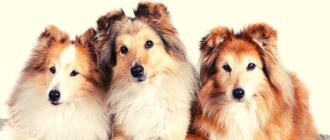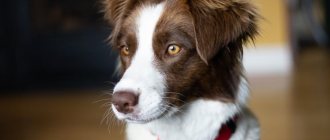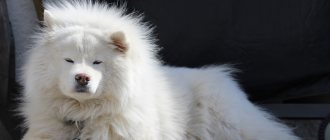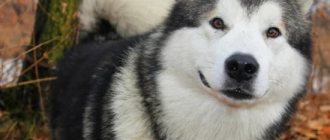Historical reference
The homeland of the Sheltie breed is the Shetland Islands, located off the northern coast of Scotland. On them, such a small dog served only as a “manager” of the herd, and not as a guard. Since the herds were small, the Shelties coped admirably.
As herds began to grow larger, farmers began using larger sheepdogs, putting the breed at risk of extinction. However, the breed was saved by lovers who perceived it as a decorative, indoor dog.
There are 2 versions about the origin of the breed:
- the first states that they were bred from Border Collies by crossing with other herding breeds;
- According to the second version, Sheltie appeared as a result of crossing Spitz with Scottish herding breeds.
To date, Sheltie breeds have been pure bred for over 140 years.
Breed traits
Breed traits (on a 5-point scale)
| Sheltie (Shetland Sheepdog) | |||
| Activity | in the house | 3.1 | |
| on the street | 3.8 | ||
| Obedience | training | 4.7 | |
| strangers | 4.6 | ||
| Domination | in family | 1.5 | |
| over dogs | 2.1 | ||
| Defending your territory | from people | 2.1 | |
| from dogs | 2.5 | ||
| Sociability | in family | 4.7 | |
| with strangers | 2.8 | ||
| with dogs | 2.9 | ||
| Concentration | in family | 1.4 | |
| in front of strangers | 3 | ||
| with dogs | 2.4 | ||
| Aggressiveness | in family | 1.2 | |
| to strangers | 1.8 | ||
| to the dogs | 1.9 | ||
| to cats | 1.9 | ||
| Family behavior | calmness | 4.7 | |
| demand for affection | 4.3 | ||
| excitability | 3.9 | ||
| playfulness | 4.3 | ||
| excessive barking | 3.5 | ||
| behavioral breakdowns | 1.9 | ||
| Tolerance for children | up to 4 years | 3.5 | |
| over 4 years old | 4 | ||
| Institutional use | watchman | 4.3 | |
| bodyguard | 1.9 | ||
This breed is often compared to the following dog breeds: Border Collie, Longhaired Collie, Australian Shepherd (Aussie), Pembroke Welsh Corgi, Schipperke.
The photo shows what a Sheltie looks like:
Description of the breed
Standard of the International Cynological Federation FCI No. 88 dated 08/19/2013 “Shetland Sheepdog”. Group 1 “Shepherd and cattle dogs, except Swiss cattle dogs.” Section 1 “Shepherds”.
Descriptions of the Sheltie breed include short stature (only 33-40 cm) and a symmetrical silhouette.
Muzzle with a pretty expression. The skull is flat, moderately wide between the ears. The cheeks are flat, the nose, lips and their rim are black. The paws are oval, with dense pads, the toes are arched and closed. The tail is unbroken, richly covered with hair, and slightly curved upward. The dog's movements are flexible and smooth, even graceful.
Eyes are a very important feature that gives expressiveness to the entire appearance of the Sheltie. They are almond-shaped, dark brown, and medium in size.
The Sheltie breed standard includes a double, lush coat: a soft undercoat, an outer coat that is long, straight, and hard with a rich collar in the mane area. Accepted color:
- sable - shades or pure colors from light gold to juicy makagoni;
- tricolor - deep black with red-brown markings;
- Blue Merle is a pure silvery blue with black flecks and marbling.
- bicolor - black and white, or black with red-brown.
Breed characteristics
This is an ideal pupil for participation in training competitions.
In addition to exceptional loyalty and high trainability, Sheltie:
- loving;
- affectionate;
- calm;
- vigilant;
- smart;
- friendly.
The main difference between Sheltie and Collie is character traits. The Collie is greatness and dignity, one might say the Nordic character, while the Shetland Sheepdog is an energy dog.
The breed is very talkative, but with a couple of prohibitive exercises this can be stopped. They treat strangers with caution and will always warn about strangers when approaching their home.
The Sheltie is a very active dog and needs constant attention.
Sheltie: the characteristics of the breed contain a constant need to be a full-fledged member of the family. From the tips of his ears to the tip of his tail, this is a family dog, enthusiastic and sociable, great with children.
The Sheltie has an exceptional sense of smell, so she can easily find lost things. You should not offend the dog, because, in addition to a phenomenal sense of smell, it also has an excellent memory, which is why these dogs will not follow commands simply out of a desire to annoy you. The most important thing in their training is the reward system.
Dog kennel from the Count's Estate. Sheltie Russian Longhaired Toy Terrier
Take the Attention Test! Find 10 differences! (click right here!)
Find the answer Are you bothered by some problem or question? Enter “Breed” or “Name of the problem” into the form, press Enter and you will find out everything about the issue that interests you.
| Description: | I sell Sheltie puppies of different ages and colors, leading English lines, professional kennel RKF, the best Sheltie kennel in Russia -2005,2006,2008, our dogs are winners of the World and European Championships. Puppies are vaccinated according to age, assistance in raising and raising, tel. 8-926-219-28-83, website www.sheltie-graf.ru |
| Contacts: | T.8-926-219-29-83 |
https://dog-care.ru/porody/pitomniki/sobak-shelti-shetlandskaya-ovcharka-v-moskve.html
| Description: |
| Contacts: |
Care and maintenance
Caring for Sheltie is largely determined by the properties of luxurious wool. It requires increased attention, otherwise it can roll up, crumple and turn into felt boots.
Shelties are usually brushed once every week or two before regular bathing. In the warm season or simply in a hot climate, as well as during seasonal shedding, the dog is washed and combed more often, getting rid of dead hair. Sheltie is very clean and takes care of her appearance - she grooms herself like a cat.
It is strictly forbidden to cut them, as cutting them disrupts the hormonal balance.
Nails are trimmed once a month. And since Shelties love to splash, a shower can become a daily procedure for the dog; With shampoo, the dog should be bathed no more than once a month.
How long do Shelties live? With proper care and feeding, they please the owner for as long as possible - about 15 years.
Nutrition. What to feed the Sheltie? Professional breeders answer this question simply - everyone!
Complementary feeding is important for a puppy, since up to 1.5 months, Shelties feed exclusively on their mother’s milk. For an older puppy, rice and millet porridges are cooked in water; there must be bowls of water and milk next to the porridge.
Upon reaching 4-5 months, you can start adding meat to the porridge. Subsequently, the adult pet is fed twice a day with either natural food or dry food.
Don't think that store-bought dog food is harmful - this is a common mistake. Dog handlers have recognized the usefulness of such foods due to the abundance of microelements and vitamins in them, which a growing body cannot do without.
If dry food is chosen as food, then the main thing is not to skimp on its quality. You should purchase premium food and higher.
Compared to an ideally selected natural diet, high-quality dry food is often cheaper.
Advantages and disadvantages
The Shetland Sheepdog, like many other medium-sized breeds, has characteristic strengths and weaknesses.
Minuses:
- unreliable security guard (it is unsafe to leave a child with him on the street);
- complex grooming;
- not suitable for people who like a passive lifestyle;
- predisposition to a large number of diseases (cataracts, hip dysplasia, testicular tumors in males).
Pros:
- a great family friend;
- easy to train;
- has a sensitive sense of smell;
- can and should be kept in an apartment;
- keeps up with people with an active lifestyle.
This is an energetic dog with a luxurious coat and a rich background. Think about whether you are ready to give a Sheltie your home, are you ready for long and energetic walks, are you ready to care for the coat so that it does not turn into felt boots? If yes, then this dog is for you. Try to become her a good friend and a kind, caring owner.
Additionally, check out the video, the main character of which is the Sheltie dog: a description of the breed, characteristic skills and much more.
Education and training
Sheltie, one of the smart and kind breeds, is a pleasure to raise. Experts say his mental abilities are similar to those of a 3-year-old child.
Such a dog needs to be raised very gently. She will never become disciplined if she is afraid of you. Hitting an animal is prohibited! Use exclusively the carrot method in his upbringing, or rather gentle persuasion, encouragement and reward.
As punishment - only verbal punishment. But remember, those who do not tolerate Sheltie screaming. Loud noises frighten gentle dogs; they become cowardly and unsure of themselves if they live in an atmosphere of abuse.
What should you teach such a dog first?
- Come when called.
- Do not climb onto the dining table and beg for food.
- Do not shit in the house, but relieve yourself only on the street.
- Make friends with other pets, as well as with children.
- Notify the owner of the arrival of guests to the house.
- Behave appropriately while walking.
The Sheltie is easy to train and easy to train.
The Shetland Sheepdog is very inquisitive. Excessive curiosity often makes her break out into the street in order to rush forward faster. This cannot be allowed. Remember, the animal should walk next to you when you lead it on a leash and under no circumstances pull it forward. The best “cure” for this kind of behavior is a strong tug with the leash.
Sheltie dog. Description, features, care and price of the Sheltie breed
Little collie, red wisp, fluffy energizer and more. And this is not a complete list of what owners call their Sheltie . So what is he, a typical representative of this, without a doubt, one of the most harmonious breeds of dogs?
The history of the Shetland Sheepdog goes back several centuries. The exact ancestors are not known for certain, but there are suggestions that Scandinavian and Icelandic dogs took part in the origin.
The Sheltie was created to help herd small flocks of sheep in difficult climatic conditions. Their small size, clear voice and energetic character have made these sheepdogs popular in the Shetland Islands for a very long time.
But at the end of the 19th century, the herds began to increase. Small farms were gradually replaced by large farms. And the Sheltie breed was almost on the verge of extinction.
Fortunately, there were those who wanted to continue to keep this smart and devoted dog, considering that all these qualities are suitable for everyone’s favorite. After all, this is precisely the main characteristic of the Sheltie breed : intelligence, devotion, obedience and liveliness of character.
Features of the Sheltie breed and character
The Sheltie is a perfect family dog. She is friendly and even in her attitude towards everyone. Of course, all outsiders will be tracked, but this is simply wariness and vigilance towards strangers, and not aggression.
Shetland Sheepdogs have not lost their herding qualities to this day. Living in apartments, they will try to get the whole family together, including the cats.
And in the private sector they do an excellent job of grazing goats or poultry. In addition, they can drive away small predators, because this was also part of their duties in their ancestral homeland.
The specificity of origin leaves its mark on behavior, so one should not expect serious protective qualities from this shepherd dog. The maximum is barking. But the Sheltie is a master at this.
It is perhaps difficult to find a more talkative dog, their language is so diverse. Sheltie puppies, almost from birth, convey all their emotions by barking, squeaking, grunting, grumbling and other sounds.
Due to their great external similarity, these dogs are called mini collies, but this is not true. Yes, to preserve the population, the blood of Scottish Shepherds, as well as Borders and German Spitz, was infused.
But Shelties were known long before that, although they were not so woolly. Shetland Sheepdogs are a self-sufficient breed and matings between Collies and Shelties are strictly unacceptable.
Pay attention to the photos of Shelties on the Internet: the joy of movement. Representatives of this breed are very active and impetuous. Any shepherd is not for the lazy. Don't think that once you buy a Sheltie puppy , you can continue to lie on the couch.
Will not work. If you do not provide the puppy with sufficient physical and, more importantly, psychological stress, then soon the baby will find something to do on his own. And it's likely you won't like it.
Reproduction and lifespan
Shelties are charming shepherd dogs with sociable inclinations and a good disposition. They are smart, loyal and sociable. Every breeder knows how to distinguish a purebred representative of the breed from an ordinary fluffy mongrel. There are a number of signs by which he can do this:
- The Shetland Sheepdog's coat should be shiny, long and rough to the touch.
- There must be a light mark on her sternum.
- The tail of such a dog should be low and hang down evenly, and not lie on the back in a “ring”.
- There are 42 teeth in her mouth.
- There are no dewclaws on the front paws.
When a Sheltie bitch is in heat, the breeder should monitor her mood and well-being. He must wait until the 4th day of her menstruation and then go with her to the male dog's house. He will definitely sniff the female, after which he will demonstrate to her his interest in mating.
She, in turn, can accept his advances, or push him away. In the second case, their meeting will have to be rescheduled for another day. Life expectancy with proper and timely care is from 14 to 16 years.
Description of the Sheltie breed
Small, but not dwarf (ideal height for males is 37 cm, for females 35.5 cm). Long-haired, but not a shaggy “ball of hair.” Strong, well muscled, but not clumsy. Slightly stretched format. The dog has the breed's sweet expression on its face, giving an overall impression of elegance, but without sophistication.
Head, with a flat skull and cheeks, tapering evenly from the ears to the tip of the nose. The transition from forehead to muzzle should be slight but clearly defined. The bite is only scissor bite with a full set of teeth.
Strong, symmetrical jaws with dense lips. Medium size, proportional to the muzzle, very expressive almond-shaped eyes set obliquely. The color is dark brown, with the exception of representatives of the merle color.
In this case, a blue color is acceptable, with possible brown veins. The small, closely spaced, semi-erect ears have slightly forward-curved tips.
Since this is a working dog, the standard very clearly stipulates what the quality of the dog’s coat should be. The spine is straight, of good length, hard to the touch.
The undercoat is somewhat shorter, softer, but very dense. The muzzle and lower part of the paws have short hair. Individuals with short hair on the body are unacceptable and will be disqualified.
Officially, there are several colors, but the nose and lips must be black in any case. The presence of white markings is acceptable for all colors except black with brown markings.
Spots can be located on the tip of the tail, paws, in the area of the chest and collar, as well as on the dog’s forehead. In principle, a dog’s score will not be reduced for the absence of spots, but their presence is still preferable.
Shelties with white spots on the body are disqualified. All colors and shades of acceptable colors must be clearly expressed. Wolf or gray shades of coat are very undesirable.
Sable color is one of the most common. It has a large number of color variations: from light golden (not yellow) to mahogany color.
The tri-color color is very elegant, due to the deep black color on the body and intense red, almost red, tan on the paws, tail and chest. The brightness of the color is valued (black should be black, without gray or brown patina).
The marble color is unusual, but it also has its admirers. Pure black spots, shades of rust or wet asphalt are prohibited, both on the undercoat and on the coat.
The absence of red-brown tan marks is not punished, but their presence is still preferable. The merle color should be pure with an overall effect of silver-blue coat. Bicolor colors are also allowed: black and tan and black and white.
Kinds
The Sheltie breed was standardized once, so its varieties are not distinguished. However, these wonderful shepherd dogs can be classified by color. Possible options:
- Black-red-white (more common than others).
- White black.
- Blue-red-white (blue morel).
- Sable.
High-breed representatives are united by the presence of a large white spot on the sternum. There may also be light markings on dogs' paws and faces. Their presence in these areas is preferable. But reddish-brown spots on the Sheltie’s body are extremely undesirable.
Sheltie care and maintenance
The Sheltie is a universal dog for all family members, who feels great in any conditions. It is important for her that the owner is nearby. It doesn’t matter to the dog whether they live in a private house or a penthouse.
The only thing that the owner should take into account is the sharp temperature limit, especially in apartments. This can have an adverse effect on your pet's coat.
You may need additional care products to maintain this magnificent coat. Otherwise, Shelties are unpretentious, like real working shepherd dogs.
There is also nothing complicated in terms of care. It is enough to brush your Shetland Sheepdog 2-3 times a week. Or as needed if you walk a lot in the fields. During shedding, brushing should be done daily.
Preferably with washing, for faster removal of dead hairs. After all, only with proper care will your dog be a sheltie whose photo you can proudly show to everyone.
How to choose a Sheltie puppy
To buy a purebred Sheltie puppy, you need to contact a good kennel or a reputable breeder. You need to study the parents’ documents, get to know the mother, and the living conditions of the animals. It is better to buy a dog with a pedigree and a veterinary passport. The price of such a pet in Moscow starts from 20,000 rubles. Dogs with breed defects or hereditary diseases are sold for 10-15 thousand.
When choosing, pay attention to active, non-cowardly and non-aggressive puppies. The baby should be well-fed and playful. It should not itch or smell unpleasant. A healthy puppy has soft, thick fur and clear eyes. When choosing a sex, you need to take into account that females are more expensive, but they are more affectionate and obedient. Males look brighter and more attractive, but tend to dominate and are more active.
The photographs show what Sheltie puppies look like:
An interesting video will complement the characteristics of dogs of this breed:
Video: Sheltie everything about the breed. Interesting Facts.
Video: Sheltie. The most interesting thing about the breed!
The Sheltie is a versatile dog. She gets along well in a large house and a small apartment, in a family with children and with a lonely pensioner. Suitable for inexperienced owners, the main thing is to love the pet and pay attention to it. Then this cute, affectionate dog will give you a lot of love and joy.
Origin
There are no detailed facts in history regarding the appearance of the breed. It is known for certain that Shelties were bred on the Shetland Islands (160 kilometers from Scotland) - 10 harsh small islands, whose inhabitants needed a miniature, agile dog for herding.
This is interesting! According to one version of the history of the breed, the Sheltie was bred on the basis of the genetics of the northern Spitz-type. Next came the blood of spaniels, Icelandic and Greenlandic shepherds, Schipperkes and long-haired collies.
Shelties are very similar to collies
The result was a small, fast, alert shepherd who was ideal for handling a flock of sheep alone. Sheltie is a universal breed of dog that can herd a herd, preventing it from scattering across the area, drive livestock from the grazing area to the paddock, and notify the shepherd that a stranger is approaching the sheep.
By 1914, the Shetland Sheepdog had acquired its final appearance. In 1948, the official breed standard was included in the stud book. And in Russia it appeared only about 25 years ago. But it never became widespread, despite its versatility and attractiveness.
History of the origin of the breed
The Sheltie or Shetland sheepdog was bred in the north of Scotland. These small shepherd dogs have been helping people for a long time. They were perfectly adapted to the harsh Scottish conditions. Their small stature and agility helped them manage flocks of sheep and herd them together.
For a long time they lived only on the territory of the Shetland Islands. No selection was carried out; the dogs were crossed with local breeds: Spitz, border collie, King Charles spaniel, Schipperke. The indigenous people called them "fairy dog" or "fairy dog." They were valued for their sharp mind, obedience, and efficiency.
These dogs were popular on Scottish farms until the 19th century. As farms began to grow, large breeds of sheep were developed. The small shepherds could no longer cope with the flock. They were replaced by larger shepherd dogs, and the Sheltie began to disappear.
English breeders saved the breed by turning the shepherds into domestic companions. At the beginning of the 20th century, the first club was created and its modern name appeared. Scottish Shelties came to America and spread throughout the world. The requirements for their appearance changed several times. At first they looked more like Spitz dogs. Then they began to be crossed with long-haired collies, so now the difference between these breeds is almost unnoticeable.
The Sheltie breed received recognition after the Second World War. The final standard was approved in 1948. They appeared in Russia only in the mid-90s, but did not become very popular.
Description of appearance
The description of the Sheltie breed should begin with a striking resemblance to a collie. Externally, an adult Shetland Sheepdog is indeed very similar to a small Scottish Sheepdog. But they are very different in size, temperament, and behavior.
Color options: tricolor and bicolor.
- sable;
- marble blue;
- black and white with red tan;
- gray-black with white or bright red tan markings.
Bicolor is observed less frequently and occurs:
- black and white;
- red and white.
Sheltie colors are very beautiful
The average weight of a Sheltie ranges from 5 to 10 kilograms. Sizes vary significantly by gender. The average height at the withers for males is 34 – 39 cm; rarely the size reaches 40 cm, in females it is 33 – 38 cm. Sexual dimorphism in Shetland Sheepdogs is very pronounced.
- eyes are slanting, medium-sized, almond-shaped, brown or blue;
- the ears are V-shaped, small, semi-erect, close to each other;
- the transition from the forehead to the muzzle is weakly expressed;
- the head is narrow, moderately long, wedge-shaped, cheekbones are flat;
- the muzzle tapers towards the nose, the lips are tightly pursed, the nose is pigmented black;
- scissor bite, tight;
- the neck is high-set, long, muscular, without dewlap;
- the chest is narrow, protruding, slightly drooping;
- the back is straight and dry. The withers are moderately pronounced, the ribs are convex;
- the lower back is rounded, strong, and has no sharp angles;
- the tail is set low, well feathered, in a calm state below the hock joints, when moving the dog holds it no higher than the level of the back;
- the limbs are straight, thin, parallel, the pasterns are flexible, the hocks are clearly defined, the hips are strong and strong;
- The coat is straight and a little rough to the touch. The undercoat is thick and dense. The mane on the neck is lush, the hind limbs have pronounced trousers.
When visually assessed, the Shetland Sheepdog looks like a light, proportionally built, agile dog, with an intelligent, lively look. Movements are free, graceful, without lameness or other abnormalities.
The Sheltie breed standard has been officially recognized since 1948.
This is interesting! You can tell whether a Sheltie is an adult or a Collie puppy by looking closely at the shape of the chest. The Sheltie is clearly similar to the Spitz-type, with the same protruding chest and a shorter muzzle than the Collie.
Faults leading to disqualification include short-haired (smooth-haired) individuals, dogs with large ears, and representatives with an overly prominent forehead. Other defects of the breed include undershot or underbite, an incomplete set of teeth, a ring-shaped tail, a completely white color, any nose pigment other than black, erect ears, a height of less than 30 cm (the so-called “dwarf sheltie”).
Characteristics of the Sheltie breed
The Sheltie has a truly ideal character. A good-natured, lively, intelligent, soft, friendly, even somewhat intelligent and pliable dog.
Their main feature is a pronounced herding instinct. We are ready to herd everything that moves: cats, geese, members of our family. What is noteworthy is that each dog is individual, each has its own herding tactics.
Shetland Sheepdogs have a personality that suits everyone. She will get along well in a large family with small children and will become a faithful companion and companion to a lonely person. Even a novice dog breeder can handle a Sheltie, and a professional trainer can have high hopes for winning sports competitions.
Good-natured, lively, smart, soft, friendly - these are the epithets that are ideal for describing the Sheltie’s character
Cheerful, mischievous dogs are eternal puppies. At the same time, they are incredibly pliable, attentive, and able to adapt to the state of mind of the owner and the atmosphere in the house. The same individual can be mobile and active, but together with the owner, become calm and melancholy. It is impossible to say anything bad about this breed; it has absolutely no negative characteristics.
It is a fairly common belief that Shelties are very talkative and love to bark. This is true, but they are so smart that they can easily understand from the owner’s reaction when it is possible to bark and when it is not.
They have an excellent orientation toward their owner, are loyal and attached to their person. Not prone to dominant manifestations of character and stubbornness. They do not tolerate loneliness well and may even become depressed.
Sociability of the breed
Due to their incredible friendliness and desire to please their owner, Shelties will get along with anyone. They are not only friendly with other animals, but will also herd everyone who lives with them.
Shetland Sheepdogs adore children, especially members of their pack. They will tolerate any familiarity addressed to them. During a walk, you don’t have to worry about your child; the shepherd’s nanny will definitely look after him.
Shelties love children very much and allow them to do whatever they want with them.
These dogs are indifferent to strangers, literally at all. Even a little wary, but not aggressive.
Security qualities
Miniature collies are not suitable as serious guards, but they will gladly notify the owner with a loud bark about the approach of a stranger. A stranger trying to enter the house will have a hard time getting past this warning bell.
Character
Experts insist that the Shetland Sheepdog is one of the best companion dogs. She loves the people around her very much, quickly becomes attached to them, and is always nearby. This is an incredibly gentle creature who is always ready to share her love with others. It can gently rub its head against its owner's hand, begging for his attention. In response to affection, he wags his tail cheerfully.
The dog is very friendly. Rancor is not characteristic of her. He always warmly welcomes guests, does not get angry and does not rush at any of them. Even drunk people do not cause negative emotions in Shelties. If the dog understands that a particular person is inadequate, he will not interact with him, but will simply move away.
A shepherd will always find a common language with a child, because she is very sociable. Regardless of age, such a dog will definitely enjoy playing with the baby. All herding dogs are good house sitters, and Shelties are no exception.
Sheltie is often considered a small collie, but they are completely different breeds of dog in their own right.
Strangers may be viewed with distrust, especially if they do not interact with others respectfully. They have an extremely negative attitude towards anger, manifestations of aggression of any kind, screaming, etc. Such a dog is deeply hurt by someone else’s abuse, since by nature it is very vulnerable and sensitive. But she herself is rarely offended.
However, even such a cute dog is capable of vanity. No, his self-esteem is not inflated, it’s just that a beautiful animal knows his worth and will not allow him to be treated without respect. He needs not only care, but also support, adequate assessment and even admiration. Praising your beloved owner will make him very happy.
Interesting! The Shetland Sheepdog can make many interesting sounds. And her “arsenal” includes bird chirping, cat purring and barking typical of dogs. It can be either noisy or quiet, depending on your mood.
Life expectancy, health
Shelties can safely be called the longest-livers of the dog world. Some individuals live up to 20 years. The average life expectancy is 14 – 15 years.
There are no special health problems. A certain tendency towards inheritance of eye diseases has been noticed. With low physical activity, excess weight may occur. Rejection of the height standard is more common; there are both “overgrown” and “undersized”. Also, Shelties have very sensitive digestion, so you need to take a responsible approach to choosing a diet.
Dogs that greatly outgrow the standard may suffer from arthritis and other similar conditions. Representatives of the breed may also have hypothyroidism, retinal degeneration, and cataracts.
All responsible breeders to avoid diseases in their litter. Before mating, future parents are taken to veterinary clinics and undergo special tests for predisposition to genetic diseases. Dogs with identified abnormalities are not allowed to be bred. Therefore, if you buy a puppy from a good nursery, there is a good chance you will get a really healthy dog.
This is interesting! The genetic game of this breed is such that it is impossible to even approximately say how many puppies will be in the litter of Shetland Sheepdogs. One female brings 3–4 puppies, the second can bear 7 or 8. Multiple pregnancies usually occur in larger females.
Sheltie puppies require a lot of attention, just like small children. If they have nothing to do, they can play pranks and cause damage in the house, especially when changing teeth. You need to start working with them from the first day in the house. Since these are great intellectuals, in the absence of mental stress, they can exhibit destructive behavior.
Mental stress is necessary for a puppy from the first days of its arrival in the house.
A puppy aged 2 to 4 months should be fed 6 times a day, in small doses. From 4 to 6 months, the portion size gradually increases, but the number of feedings decreases to 4 times a day. From 6 to 10 months, the puppy is fed 3 times a day. After 10 months, they are transferred to the adult schedule - 2 times a day.
Possible diseases and methods of treating them
Shelties have strong immunity. They move a lot and therefore hardly get sick. However, some representatives of the breed still end up at the veterinarian. Possible diagnoses:
- Hip dysplasia. Often diagnosed as a mature Sheltie.
- Allergy to food. Occurs only when the animal is not fed properly.
- Epilepsy. Congenital pathology, often found in males.
If your pet constantly scratches its eyes or ears, it may have an infection. After a medical examination, you will have to instill a special medicine into his mucous membranes. You cannot prescribe it yourself!
Remember, healthy Shelties are active, lively and curious. It is easy to understand that the dog is sick. Firstly, she will sleep a lot, and secondly, she will lose her appetite. In this case, take her to the vet.











